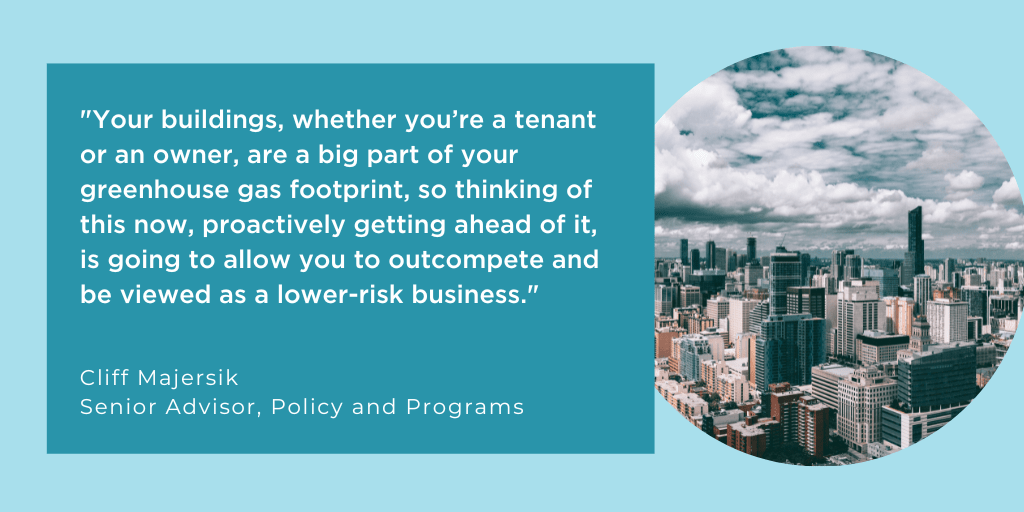A version of this interview originally appeared in BRINK, a global content platform that provides timely insights on critical business issues.
The Inflation Reduction Act — President Joe Biden’s signature climate legislation — has considerable implications for the built environment in the United States. Companies that rent office space are soon going to find themselves playing a role in the carbon footprint of their building and could be liable if their offices fail to meet low carbon-emission standards.

Cliff Majersik: The Inflation Reduction Act will have a significant impact on the built environment through building codes and other mediums. It provides a billion dollars to help jurisdictions adopt and implement very advanced building codes, including a net zero energy code. And a billion dollars actually goes a long way because implementing these building codes is relatively inexpensive. The larger costs will fall on private industry in adopting their processes to improve building performance. The private sector will have to pay more to adapt new processes, new techniques and technologies, but they’ll see a phenomenal return on investment because building better buildings in the first place is particularly attractive from a financial perspective, much more so than retrofitting existing buildings.
Buildings that have heat pumps, solar on them, better insulation, better air sealing, better systems that provide heat and hot water and ventilation and cooling and all of that will reduce energy bills and make the buildings more comfortable and healthier.
Impact on Existing Buildings
BRINK: Building codes presumably just apply to new builds. How does the act address existing buildings, which obviously are a major source of carbon emissions?
Majersik: The IRA has a number of ways of addressing existing buildings. The most direct is that there are incentives for retrofitting existing homes and existing commercial buildings. There are also incentives for ramping up manufacturing of products used to enable buildings to perform better — products like heat pumps and advanced sensors and controls. As they ramp up production, we expect to see economies of scale and rapidly falling prices further cutting costs for building owners. There’s also money provided directly to states and to cities, some of it earmarked for frontline communities that have been affected first and worst by climate change. In many cases, the money can be used for upgrading buildings. There’s also money for reconnecting communities that were torn apart by racist policies that put highways and other infrastructure through communities of color.
Building Performance Standards
In addition to the IRA, another major element increasingly in play is building performance standards, which have been adopted by three states and 10 localities, with another 27 around the country committing to adopt them by 2024 through President Biden’s National Building Performance Standard Coalition. These are laws that require that existing buildings improve their performance, measured either in energy or carbon, and they apply to all buildings. The improvement requirements ratchet up over time and are the most fundamental building blocks for these jurisdictions to achieve their ambitious climate commitments.

Moving Away From Gas in Commercial Buildings
BRINK: Are we looking at the end of natural gas as a heating utility?
MAJERSIK: Yes, we’re moving in that direction, but it will occur at different paces in different places. Some people think biogas can be a bridge to decarbonization. But, there are very limited supplies of biogas that can be captured from landfills and industry. That supply should be reserved for industrial processes and other processes that require high heat and cannot easily be electrified.
As we decarbonize and strengthen our electric grid, it can support increased demand from all-electric buildings, while existing gas equipment can provide additional heating capacity for particularly cold winter days in particularly cold parts of the country. The bottom line for business is that the move away from gas is already underway, and you don’t want to get left behind.
There will be a transition which needs to be navigated carefully and with extensive long-term planning. And, in particular, we need to pay attention to frontline communities. Folks who can least afford both increased utility bills and making investments in new equipment in their homes. So, equity needs to be really front and center as we plan this massive transition so that we have a just transition.
Office Tenants Could Be Liable for Carbon Footprint
BRINK: What are the implications for a company with office space in an existing building? How can they prepare for this?
MAJERSIK: The Securities and Exchange Commission has recently published draft rules requiring that companies disclose their climate risks, including transition risk. Transition risk is that as changing priorities and new policies drive the nation to decarbonize, there will be impacts on markets, on property values, and there will need to be huge investments in decarbonizing buildings. Part of that will be coming from these new building performance standards. They can create real liabilities for a company if you don’t get out in front of it and improve your buildings. So if you’re an office tenant, say, when you go to lease new space, you should think about looking for high-performing buildings. Your buildings, whether you’re a tenant or an owner, are a big part of your greenhouse gas footprint, so thinking of this now, proactively getting ahead of it, is going to allow you to outcompete and be viewed as a lower-risk business.
Environmental Performance Signals Good Management
A lot of investors look at businesses environmental performance as a heuristic for understanding management quality. investors are looking for well-managed companies, and it’s hard to measure management quality. Companies that are doing a really good job of lowering their greenhouse gas emissions are a good risk from an investment perspective.
BRINK: But would a company that has a tenancy in a building be liable for a failure to adjust or does that risk fall on the owner of the building?
MAJERSIK: It depends on the leases and also depends on how the law is written. A lot of law firms are now assessing that question on a lease-by-lease basis. How much, if any, of these costs can be passed through to the commercial tenants? Residential tenants are not going to be liable, but commercial tenants in many cases will be liable. Going forward, landlords will write provisions into their leases to assure that their commercial tenants share in the liability. That’s important because commercial tenants have to be part of the solution. So it’s appropriate that they have skin in the game and want to see a building comply with these building performance standards.
